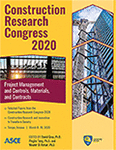Construction Research Congress 2020
Treatment of Concurrent Delays and the Prevention Principle in Construction Delay Claims
Publication: Construction Research Congress 2020: Project Management and Controls, Materials, and Contracts
ABSTRACT
Delays are bound to be experienced on construction projects, and numerous taxonomies have been devised for their classification. Delay-related events that are found to be particularly caused by owners or contractors are likely to give rise to delay concurrency disputes. Another form of difficulty arises when such disputes involve the alleged triggering of the prevention principle in respect of a relevant delay event that is caused by the owner. The paper aims at tackling the treatment of concurrent delays under those conditions that lend themselves to the triggering of the prevention principle. The adopted methodology involved a review of the literature on the types of construction delays and the difficulties associated with their identification and measurement, as well as their patterns of occurrence, including delay concurrency and pacing. It further involved a review of a number of relevant case law on the subject, which allowed a set of lessons learned to be withdrawn. The methods of enquiry that were observed to have been relied upon in deriving resolutions involve the employment of the malmaison approach, the dominant approach, and/or the apportionment approach. The lessons learned are found to have revolved around several critical factors that have been identified to include: the timing at which the events took place, the sequencing with which the events occurred, the level of ambiguity of the contract clauses related to the concerned delay events, and the responsibility for carrying the burden of proving that the relevant events have indeed affected completion.
Get full access to this article
View all available purchase options and get full access to this chapter.
REFERENCES
Works Cited
Abdul-Malak, M. A., and Jaber, A. E. (2018). “Multi-layered framework for testing the justifiability of time-at-large callings.” J. Leg. Aff. Dispute Resolut. Eng. Constr., 10(3): 04518014.
Abdul-Malak, M. A., and A. Jaber. (2017). “Project conditions justifying time-at-large claims.” Resilient structures and sustainable construction. ISEC Press, Greenwood Village, CO.
Arditi, D., and Pattanakitchamroon, T. (2008). “Analysis methods in time-based claims.” J. Constr. Eng. Manage., 134(4), 242-252.
Arif, F., and Morad, A. A. (2013). “Concurrent delays in construction: international legal perspective.” J. Leg. Aff. Dispute Resolut. Eng. Constr., 6(1), 04513001.
Baram, G. E. (2000). “Concurrent delays--what are they and how to deal with them?” AACE International Transactions, R71-R78.
Golanaraghi, S., and Alkass, S. (2012). “Modified isolated delay type technique.” Proc., 2012 Construction Research Congress (CRC2012), ASCE, West Lafayette, IN.
Joseph, B. (2015). “Legal analysis of concurrent delay claims in construction projects and evaluation of entitlement using apportionment principle.” <http://bspace.buid.ac.ae/handle/1234/821> (October 22, 2018).
Kraiem, Z. M., and Diekmann, J. E. (1987). “Concurrent delays in construction projects.” J. Constr. Eng. Manage., 113(4), 591-602.
Livengood, J. (2017). “Knowns and unknowns of concurrent delay.” J. Leg. Aff. Dispute Resolut. Eng. Constr., 9(3), 06517002.
Livengood, J., and Peters, T. F. (2008). “The great debate: concurrency vs. pacing slaying the two-headed dragon.”AACE International Transactions, CD61-CD617.
Marrin, J. (2013). “Concurrent delay revisited.” Society of Construction Law, <https://www.scl.org.uk/papers/concurrent-delay-revisited> (June 18, 2019).
O’Leary, D. (2014). “Dealing with concurrency in construction delay claims.” Al Tamimi & Company, <https://www.tamimi.com/law-update-articles/dealing-with-concurrency-in-construction-delay-claims/> (June 18, 2019).
Rubin, R. A., Guy, S. D., Maevis, A. C., and Faiweather, V. (1983). Construction claims: analysis, presentation, defense, Van Nostrand Reinhold (VNR) Co., New York.
Society of Construction Law. (2017). “Delay and Disruption Protocol”, 2nd Edition. Society of Construction Law, Hinckley.
Vasilyeva-Lyulina, A., Onishi, M., and Kobayashi, K. (2015). “Delay analysis methods for construction projects: Mathematical modelling.” Int. J.Transp., 3(1), 27-36.
Zack, J. G. (2000). “Pacing delays-the practical effect.” Cost Engineering, 42(7), 23-28.
Information & Authors
Information
Published In
Construction Research Congress 2020: Project Management and Controls, Materials, and Contracts
Pages: 1293 - 1301
Editors: David Grau, Ph.D., Arizona State University, Pingbo Tang, Ph.D., Arizona State University, and Mounir El Asmar, Ph.D., Arizona State University
ISBN (Online): 978-0-7844-8288-9
Copyright
© 2020 American Society of Civil Engineers.
History
Published online: Nov 9, 2020
Published in print: Nov 9, 2020
Authors
Metrics & Citations
Metrics
Citations
Download citation
If you have the appropriate software installed, you can download article citation data to the citation manager of your choice. Simply select your manager software from the list below and click Download.
